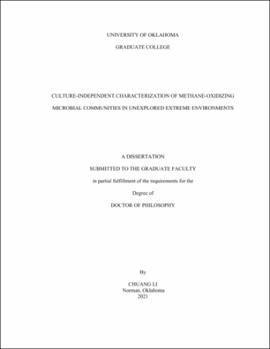| dc.description.abstract | Methane is the second most abundant greenhouse gas in atmosphere. With increasing emissions and more effective in trapping heat than CO2, it contributes up to ~20% of total global warming. Methanotrophs playing a critical role in mitigating the amount of methane released to atmosphere, have received attention from the scientific community. However, the distributions of methanotrophs in extreme environments are still poorly understood, but where their roles are likely significant: a) They can be an overlooked sink for methane; b) They may influence the in-situ carbon flow and community-wide functions by serving as the primary producer; c) Novel extremophilic methanotrophs have the potential to be used as bioremediation and biomanufacturing agents with novel metabolic potentials. In an effort to understand better the methanotrophic ecology in unexplored extreme environments, we investigated the composition, diversity, abundance and interacting relationships of methane-oxidizing microbial communities using culture-independent methods in two ecosystems encountered with combination of multiple environmental stresses: including cyanobacterial bloom aggregates (an eutrophic ecosystem with unusual limnological extreme conditions in surface freshwaters including fast-fluctuating oxygen and pH gradients, strong light intensity input, cyanotoxins-tainted poor water quality) and Sanford Underground Research Facility (SURF) in the former Homestake gold mine (an oligotrophic ecosystem with unusual geo-physicochemical extreme conditions in terrestrial subsurface including higher pressure, deficient oxygen, toxic metals, high temperature and no light input).
Fueled by excessive nutrient input and global warming effect, cyanobacterial harmful algal blooms (cyanoHABs) are occurring with increasing frequency around the world, which can severely impact the health of humans and threaten the sustainability of the global freshwaters through releasing toxins and causing anoxia. Although eutrophication and the occurrence of cyanobacteria in oxic surface waters have been positively associated with methane emissions in lakes, the linkage to cyanobacterial blooms has gained little scientific attention. Here, Microcystis-blooms aggregate samples were collected from ten lakes across four continents and eight countries. Given the roles of methanotrophs in reducing methane emissions and modulating carbon flow, methanotrophic communities associated with floating Microcystis aggregates were surveyed through sequencing of the marker genes. Our results indicate methanotrophs are present in all samples and relatively enriched in three of the ten lakes, with the majority associated with gammaproteobacterial lineages. Methanogenic archaea as the potential methane source in aggregates are also detected in half of the ten lakes. We further quantified the abundances of the three co-occurring microbial groups (cyanobacteria, methanogens and methanotrophs) to infer their relationships at a functional level. Abundance of methanotrophs is strongly positively correlated with those of methanogens, suggesting coupled activities of methanogenesis/methanotrophy. We are using the commonality and correlation across disparate geographies as a first step in assuming the functional connections, but direct measures of activities will be required to address in detail the carbon flow throughout the entire microbial ecosystem. To our knowledge, this is the first study specifically looking into cyanobacteria-associated methanotrophs, which could act as an efficient methane sink for methane produced by the “methane paradox” phenomenon in oxic surface waters and lead to diversified carbon flow within the aggregate.
Chemolithoautotrophy is generally thought of as a primary carbon and energy source for maintenance of the subsurface microbial ecosystems. As methane is commonly encountered in the deep subsurface biosphere, methanotrophy may play a fundamental role that is comparable to chemolithoautotrophy. However, methanotrophic ecology is particularly poorly characterized in subsurface environments. To comprehensively evaluate the distribution of aerobic methanotrophic population, we extracted the DNA from deeply circulating groundwaters and various types of mine shaft materials in SURF. High-throughput amplicon sequencing of marker genes reveal that methanotrophic populations (mainly classified as Methyloocccus) constitute up to ~27% of bacterial community in biofilms collected from mine shaft walls, and a high diversity of methanotrophic lineages are present in subsurface habitats. Meanwhile, several uncultivated methanotrophic lineages unreported in previous subsurface studies are observed here. We further conducted in-depth phylogenetic analysis of these two biomarkers, and the results reveal that several mine OTUs have closest relatives from other subsurface habitats, of which several groups form into a subsurface-colonizing monophylotypes, implying these SURF methanotrophs are indigenous subsurface inhabitants. The composition of bacterial communities is moderately similar between groundwaters and biofilms collected from the same depth level. Type Ib methanotrophs are likely to serve as the primary producer in biofilms as supported by the correlation patterns observed by network analysis. Finally, we successfully reconstructed ten methanotrophic genomes from metagenomic sequences, uncovering various degree of novel methanotrophic strains were indeed present in subsurface biosphere through AAI analysis and some unusual features (e.g. with possession of the pmoA2 and mmoX genes) are potentially involved in adapting to extreme conditions. To our knowledge, this is the first study specifically looking into the distribution of methanotrophs in non-cave subsurface ecosystem, where diverse, abundant and novel subsurface-adapted indigenous aerobic methane oxidizing bacteria are discovered. | en_US |
